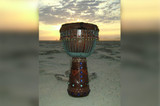How to Play the Tambourine
Tambourines are common hand percussion instruments that are seen in cultures around the world. These frame drums are known for the ability to accent a song or rhythm with a jingle and thump, so to speak, and are perfect for classrooms and the introduction of drumming and rhythm. Even with the simplicity of the instrument, there are many advanced methods to playing the tambourine that require practice, patience and determination.
Most people are familiar with tapping the tambourine with the hand or against the leg in a rhythmic manner to keep a steady beat with a song or rhythm. This method is great for teaching basic rhythms and for learning the nuances of the tambourine. When doing the “tap,” with the hands, hold the tambourine in the non-dominant hand, resting the thumb on one side of the frame while curling the fingers over it to hold the other side of the frame. For tambourines with a drum head, try tapping it closer to the frame for a more punctuated drum beat that will still move the jingles (or zils), and vary the angle with which it is held to get the best sound and decay for the song or style of music. If tapping against the leg, it is easier on the wrist to hold a tambourine with a drum head so that the drum part hits the leg, and the sound of the jingles is much cleaner.
A tambourine roll is perhaps the signature sound of the instrument, and there are a few methods for creating that sound. The first, you hold the tambourine as if you are tapping it, but, instead, use the wrist to rotate the instrument back and forth in a quick manner. Alternately, you can rest the tambourine in your lap, or against one leg, with the drum side down (if present) and use both hands to “drum” on the frame. There is also the “thumb roll” method where you drag your thumb across the head of the drum, following the circle of the frame, and the friction will cause the jingles to… jingle.
Other methods for playing the tambourine include hitting it with a mallet or drum sticks, either while held in one hand or secured with a tambourine stand, like a drum. For each time the tambourine is struck, the jingles play, giving a great accent to the beat that is perfect for all types and styles of music and events.

With various faces of the tambourine found around the world, there are plenty of ways that have been developed to take advantage of the instruments’ portability, jingles and drum surface. Adding a little tambourine to a hand percussion repertoire is always a great way to add interest and personal style to any rhythm, song or drum circle or community drum jam.
Recent Posts
-
What is the Best Size Djembe for Beginners?
If you're new to the world of percussion and interested in learning the djembe, you're in for a t …16th Jul 2024 -
The Benefits of Becoming a Drumming Teacher: Transforming Passion into Profession
Why become a drumming teacher? Becoming a drumming teacher is an excellent way to share your pas …22nd May 2024 -
What Makes the Djembe Drum a Spiritual Instrument in African Music?
Origin and history of the Djembe drum The Djembe drum originates from West Africa and holds sign …16th May 2024




